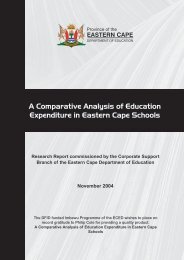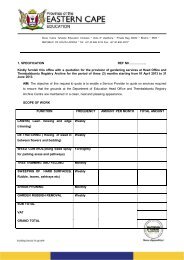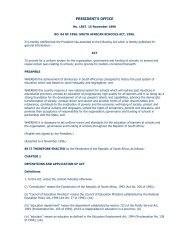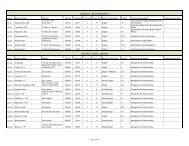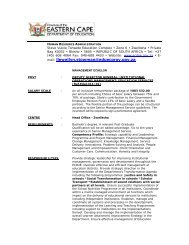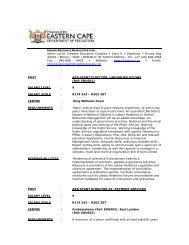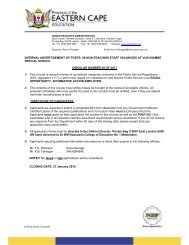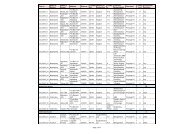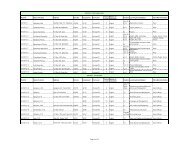Geography P2 English 2012
Geography P2 English 2012
Geography P2 English 2012
Create successful ePaper yourself
Turn your PDF publications into a flip-book with our unique Google optimized e-Paper software.
NATIONAL<br />
SENIOR CERTIFICATE<br />
GRADE 12<br />
GEOGRAPHY <strong>P2</strong><br />
NOVEMBER <strong>2012</strong><br />
MARKS: 100<br />
TIME: 1½ hours<br />
EXAMINATION<br />
NUMBER<br />
CENTRE<br />
NUMBER<br />
*GEOGE2*<br />
MARK SCORED Q1 Q2 Q3 Q4 TOTAL<br />
MARKER<br />
SENIOR MARKER<br />
CHIEF MARKER<br />
MODERATOR<br />
TOTAL 20 20 40 20 100<br />
This question paper consists of 11 pages and 1 page for rough work.<br />
Copyright reserved<br />
Please turn over
<strong>Geography</strong>/<strong>P2</strong> 2<br />
DBE/November <strong>2012</strong><br />
NSC<br />
RESOURCE MATERIAL<br />
1.<br />
2.<br />
3.<br />
An extract from topographical map 2829AC HARRISMITH.<br />
Orthophoto map 2829AC 3 HARRISMITH.<br />
NOTE: The resource material must be collected by the schools for their own<br />
use.<br />
INSTRUCTIONS AND INFORMATION<br />
1.<br />
2.<br />
3.<br />
4.<br />
5.<br />
6.<br />
7.<br />
8.<br />
Write your EXAMINATION NUMBER and CENTRE NUMBER in the spaces<br />
on the cover page.<br />
Answer ALL the questions in the spaces provided in this question paper.<br />
You are supplied with a 1:50 000 topographical map 2829AC of<br />
HARRISMITH and an orthophoto map of a part of the mapped area.<br />
You must hand the topographical map and the orthophoto map to the<br />
invigilator at the end of this examination session.<br />
You must use the blank page at the back of this paper for all rough work and<br />
calculations. Do NOT detach this page from the question paper.<br />
Show ALL calculations and formulae, where applicable. Marks will be<br />
allocated for this.<br />
You may use a non-programmable calculator.<br />
The following <strong>English</strong> terms and their Afrikaans translations are shown on the<br />
topographical map.<br />
ENGLISH<br />
Diggings<br />
Caravan Park<br />
Sewage Works<br />
River Mouth<br />
Golf Course<br />
Wetland<br />
AFRIKAANS<br />
Uitgrawings<br />
Karavaanpark<br />
Rioolwerke<br />
Riviermond<br />
Gholfbaan<br />
Vlei<br />
Copyright reserved<br />
Please turn over
<strong>Geography</strong>/<strong>P2</strong> 3<br />
DBE/November <strong>2012</strong><br />
NSC<br />
QUESTION 1: MULTIPLE-CHOICE QUESTIONS<br />
The questions below are based on the 1:50 000 topographical map 2829AC<br />
HARRISMITH, as well as the orthophoto map of a part of the mapped area. Various<br />
options are provided as possible answers to the following questions. Choose the<br />
answer and write only the letter (A–D) in the block next to each question.<br />
1.1 The main agricultural activity around Harrismith is ...<br />
A<br />
B<br />
C<br />
D<br />
crop farming.<br />
fruit farming.<br />
cattle farming.<br />
chicken farming.<br />
1.2 The recreational feature marked 1 on the orthophoto map is a …<br />
A<br />
B<br />
C<br />
D<br />
park.<br />
nature reserve.<br />
golf course.<br />
plantation.<br />
1.3 On the topographical map, Phomolong (A) in block A6/7 is an example of<br />
a/an … residential area.<br />
A<br />
B<br />
C<br />
D<br />
high-income<br />
low-income<br />
middle-income<br />
informal<br />
1.4 Which town is approximately 60 km from Harrismith?<br />
A<br />
B<br />
C<br />
D<br />
Van Reenen<br />
Warden<br />
Witsieshoek<br />
Kestell<br />
1.5 The Sterkfontein Dam is to the … of the town of Harrismith.<br />
A<br />
B<br />
C<br />
D<br />
south-west<br />
south-east<br />
south<br />
west<br />
1.6 The map index to the south of 2829AC is …<br />
A<br />
B<br />
C<br />
D<br />
2828DB.<br />
2829CA.<br />
2828BD.<br />
2829CB.<br />
Copyright reserved<br />
Please turn over
<strong>Geography</strong>/<strong>P2</strong> 4<br />
DBE/November <strong>2012</strong><br />
NSC<br />
1.7 The river in block C2 on the topographical map flows in a ... direction.<br />
A<br />
B<br />
C<br />
D<br />
south-easterly<br />
north-easterly<br />
southerly<br />
north-westerly<br />
1.8 The land-use zone numbered 1 on the orthophoto map is a …<br />
A<br />
B<br />
C<br />
D<br />
recreational area.<br />
rural-urban fringe.<br />
residential area.<br />
plantation.<br />
1.9 The street pattern of the built-up area in blocks C1, C2 and D2 on the<br />
topographical map is …<br />
A<br />
B<br />
C<br />
D<br />
planned irregular.<br />
a grid.<br />
unplanned irregular.<br />
radial.<br />
1.10 The feature labelled E on the topographical map is (a) …<br />
A<br />
B<br />
C<br />
D<br />
perennial water.<br />
non-perennial water.<br />
marsh and vlei.<br />
non-perennial river.<br />
(10 x 2) [20]<br />
QUESTION 2: CALCULATIONS AND APPLICATION<br />
2.1 Harrismith holds an annual marathon that involves contestants running via<br />
Platberg. Study both the photograph of Platberg below and the area covered<br />
by blocks A/B10, 11, 12 and 13 on the topographical map before answering<br />
the questions below.<br />
Copyright reserved<br />
Please turn over
<strong>Geography</strong>/<strong>P2</strong> 5<br />
DBE/November <strong>2012</strong><br />
NSC<br />
2.1.1 Identify the landform named Platberg.<br />
______________________________________________________<br />
(1 x 1) (1)<br />
2.1.2 Identify the shape of the slope that the contestants will be running up<br />
between points C–D (block A/B10) on the topographical map.<br />
Explain your answer with reference to the contour lines on the map.<br />
Slope<br />
______________________________________________________<br />
Explanation<br />
______________________________________________________<br />
______________________________________________________<br />
______________________________________________________<br />
(2 x 1) (2)<br />
2.1.3 Calculate the average gradient of the slope between spot height<br />
1797 and spot height 2263 in block A10 on the topographical map.<br />
Show ALL calculations.<br />
______________________________________________________<br />
______________________________________________________<br />
______________________________________________________<br />
______________________________________________________<br />
______________________________________________________<br />
______________________________________________________<br />
______________________________________________________<br />
(5 x 1) (5)<br />
2.1.4 Comment on the level of difficulty of this slope for a contestant.<br />
______________________________________________________<br />
______________________________________________________<br />
(1 x 1) (1)<br />
2.1.5 Explain why a zig-zag footpath (block A11) has been cut over<br />
Platberg.<br />
______________________________________________________<br />
______________________________________________________<br />
(1 x 1) (1)<br />
Copyright reserved<br />
Please turn over
<strong>Geography</strong>/<strong>P2</strong> 6<br />
DBE/November <strong>2012</strong><br />
NSC<br />
2.2 Using the information on the topographical map, determine the magnetic<br />
declination for this year. Show ALL calculations/steps followed.<br />
______________________________________________________________<br />
______________________________________________________________<br />
______________________________________________________________<br />
______________________________________________________________<br />
______________________________________________________________<br />
______________________________________________________________<br />
(4 x 1) (4)<br />
2.3 Refer to the feature labelled Blokhuis (4) on the orthophoto map.<br />
Draw a cross section of the feature from 2 to 3 on the axes below.<br />
1720<br />
1710<br />
1 cm to 10 m<br />
1700<br />
1690<br />
1680<br />
1670<br />
1660<br />
1650<br />
1 : 10 000<br />
(12 x ½) (6)<br />
[20]<br />
Copyright reserved<br />
Please turn over
<strong>Geography</strong>/<strong>P2</strong> 7<br />
DBE/November <strong>2012</strong><br />
NSC<br />
QUESTION 3: APPLICATION AND INTERPRETATION<br />
3.1 The Sterkfontein Dam forms an important part of the Tugela-Vaal Scheme.<br />
Refer to the diagram below (FIGURE 3.1) as well as the dam on the<br />
topographical map to answer the questions that follow.<br />
Spioenkop<br />
Driel<br />
Woodstock<br />
Killburn<br />
Driekloof<br />
Sterkfontein<br />
Drakensberg<br />
Tunnel<br />
Turbines<br />
FIGURE 3.1<br />
3.1.1 Describe the difference in position of the Sterkfontein Dam in<br />
relation to the Spioenkop, Driel, Woodstock and Killburn Dams.<br />
______________________________________________________<br />
______________________________________________________<br />
______________________________________________________<br />
______________________________________________________<br />
(1 x 2) (2)<br />
3.1.2 The Sterkfontein Dam has an ideal location for the storage of water.<br />
Give ONE reason to support this statement.<br />
______________________________________________________<br />
______________________________________________________<br />
______________________________________________________<br />
(1 x 2) (2)<br />
3.1.3 Name TWO ways in which the residents of Harrismith and its<br />
surrounding area can benefit from the Sterkfontein Dam.<br />
______________________________________________________<br />
______________________________________________________<br />
(2 x 2) (4)<br />
Copyright reserved<br />
Please turn over
<strong>Geography</strong>/<strong>P2</strong> 8<br />
DBE/November <strong>2012</strong><br />
NSC<br />
3.2 Harrismith is located in a low-rainfall area. Give TWO pieces of evidence from<br />
the map to support this statement.<br />
______________________________________________________________<br />
______________________________________________________________<br />
______________________________________________________________<br />
(2 x 2) (4)<br />
3.3 Identify the drainage pattern in blocks E/F3, 4 and 5 and give evidence from<br />
the map to support your answer.<br />
______________________________________________________________<br />
______________________________________________________________<br />
______________________________________________________________<br />
(2 x 2) (4)<br />
3.4 Refer to Nuwejaarspruit in block G2 on the topographical map.<br />
3.4.1 Is this a perennial or non-perennial river?<br />
______________________________________________________<br />
(1 x 2) (2)<br />
3.4.2 Nuwejaarspruit is in its middle course, changing to the lower course.<br />
Give TWO pieces of evidence from the map to support this<br />
statement.<br />
______________________________________________________<br />
______________________________________________________<br />
______________________________________________________<br />
(2 x 2) (4)<br />
3.5 Harrismith is a very old town that developed in the colonial era. Support this<br />
statement with ONE piece of evidence from the map.<br />
______________________________________________________________<br />
______________________________________________________________<br />
(1 x 2) (2)<br />
3.6 Refer to the dominant primary activity practiced in blocks H1 and H2.<br />
3.6.1 Identify the dominant primary activity referred to above.<br />
______________________________________________________<br />
(1 x 2) (2)<br />
Copyright reserved<br />
Please turn over
<strong>Geography</strong>/<strong>P2</strong> 9<br />
DBE/November <strong>2012</strong><br />
NSC<br />
3.6.2 Explain how the environment is likely to be affected by this activity<br />
identified in QUESTION 3.6.1 in a negative way.<br />
3.7 Refer to the N3.<br />
______________________________________________________<br />
______________________________________________________<br />
(1 x 2) (2)<br />
3.7.1 Why does the N3 NOT pass through Harrismith?<br />
______________________________________________________<br />
______________________________________________________<br />
(2 x 2) (4)<br />
3.7.2 What is the disadvantage for businesses of the N3 not passing<br />
through Harrismith?<br />
______________________________________________________<br />
______________________________________________________<br />
(1 x 2) (2)<br />
3.8 Refer to Wilgerpark on the orthophoto map.<br />
3.8.1 Wilgerpark developed much later than the original town of<br />
Harrismith. Give ONE reason from the orthophoto map to support<br />
this statement.<br />
______________________________________________________<br />
______________________________________________________<br />
(1 x 2) (2)<br />
3.8.2 Wilgerpark is a high-income residential area. Give ONE piece of<br />
evidence from the topographical map to support your answer.<br />
______________________________________________________<br />
______________________________________________________<br />
(1 x 2) (2)<br />
3.8.3 Give ONE disadvantage of the location of Wilgerpark.<br />
______________________________________________________<br />
(1 x 2) (2)<br />
[40]<br />
Copyright reserved<br />
Please turn over
<strong>Geography</strong>/<strong>P2</strong> 10<br />
DBE/November <strong>2012</strong><br />
NSC<br />
QUESTION 4: GEOGRAPHICAL INFORMATION SYSTEMS (GIS)<br />
4.1 Study the map below (FIGURE 4.1) which shows the path of the tornado that<br />
tore through Harrismith a few years ago. Many data layers were used to draw<br />
this map.<br />
HARRISMITH<br />
[Source: Goliger en Van Wyk]<br />
FIGURE 4.1<br />
4.1.1 Define the term data layering (overlaying).<br />
______________________________________________________<br />
______________________________________________________<br />
(1 x 2) (2)<br />
4.1.2 Name TWO data layers visible on the map (FIGURE 4.1).<br />
______________________________________________________<br />
______________________________________________________<br />
(2 x 2) (4)<br />
4.1.3 GIS is useful in disaster management. Explain how it would have<br />
assisted the local authorities with planning after the tornado struck.<br />
______________________________________________________<br />
______________________________________________________<br />
______________________________________________________<br />
______________________________________________________<br />
(2 x 2) (4)<br />
Copyright reserved<br />
Please turn over
<strong>Geography</strong>/<strong>P2</strong> 11 DBE/November <strong>2012</strong><br />
NSC<br />
4.2 Study the photo (FIGURE 4.2) of the N3 that bypasses Harrismith and<br />
connects Durban and Johannesburg.<br />
FIGURE 4.2<br />
[Source: Google]<br />
4.2.1 Differentiate between spatial data and attribute data.<br />
______________________________________________________<br />
______________________________________________________<br />
______________________________________________________<br />
______________________________________________________<br />
(2 x 2) (4)<br />
4.2.2 What type of spatial object (point, line or polygon) is the road?<br />
______________________________________________________<br />
(1 x 2) (2)<br />
4.2.3 Give ONE attribute that can be captured for the N3.<br />
______________________________________________________<br />
(1 x 2) (2)<br />
4.3 If a vehicle with a global positioning system (GPS) approaches Harrismith,<br />
how can the GPS assist the driver to find the hospital numbered 10 on the<br />
orthophoto map?<br />
______________________________________________________________<br />
______________________________________________________________<br />
______________________________________________________________<br />
(1 x 2) (2)<br />
[20]<br />
Copyright reserved<br />
TOTAL: 100
<strong>Geography</strong>/<strong>P2</strong> DBE/November <strong>2012</strong><br />
NSC<br />
ROUGHWORK AND CALCULATIONS<br />
Copyright reserved




